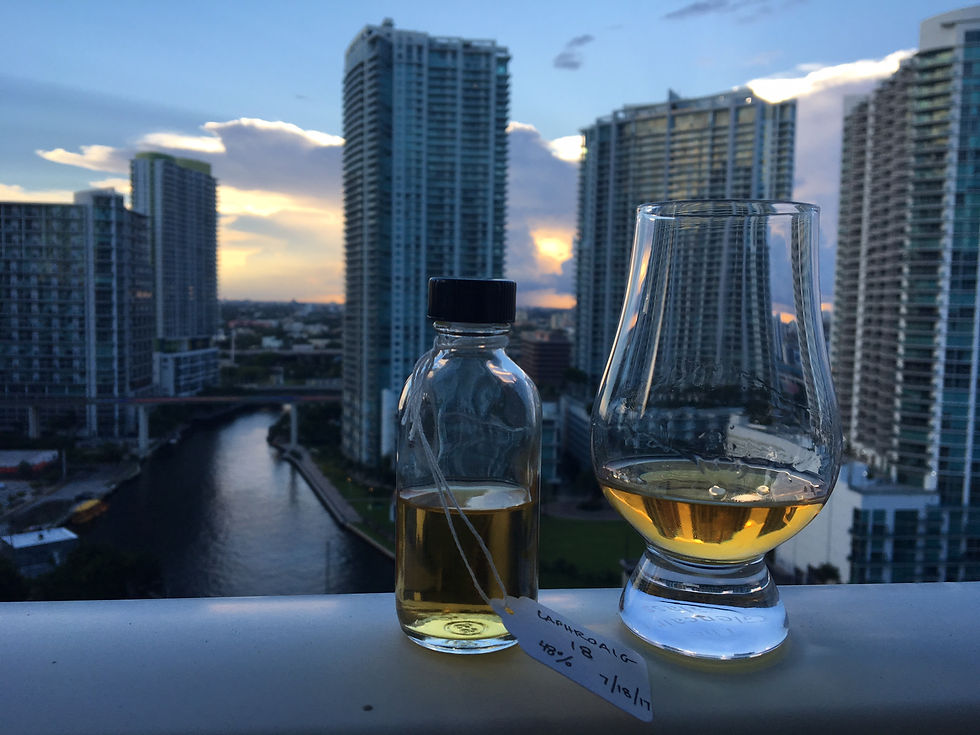Laphroaig 18 - Review
- Jason
- Aug 2, 2017
- 3 min read

Age: 18 years
Barrel type: Ex-Maker's Mark bourbon barrels
Region: Islay
ABV: 48%
Price: $150 - discontinued in 2016
Additional details: non-chill filtered, color added
Laphroaig is my favorite distillery, so it was a privilege to try their 18-year old expression. Unfortunately for us all, Laphroaig decided to discontinue this expression toward the tail end of 2016. So, while there may still be bottles on shelves all over the country, once those are tapped out, don't expect more on the way. Many thanks to the kind friend who sent me a sample of this incredible scotch -- I'm even more grateful because he hadn't opened his bottle yet, but broke it out so we could both try it!
One cool detail about Laphroaig is that the distillery sources its ex-bourbon barrels from Maker's Mark. Most distilleries do not provide this information, although there are a handful of exceptions (e.g., Kilchoman uses Buffalo Trace barrels). As a sort of double irony, before I began tasting whiskies more closely, two of my go-to bar drinks were Laphroaig 10 and Maker's Mark. Additional reflection and much more experience have confirmed that my love for Laphroaig is true, but I've come to realize that I don't really like Maker's Mark all that much. Nonetheless, I'll always remain grateful to Maker's Mark for providing one of the most crucial ingredients for producing this dram, as well as its spectacular brethren.
Appearance: No comment on the bottle appearance, since this is a two-ounce sample review. In the glass, Laphroaig 18 is summertime embodied in a liquid, with a rich, orange, goldenrod hue that is such a contrast with the more straw-like appearance of young Laphroaig. This scotch is also noticeably thicker and rests heavier in the glass than Laphroaig 10, which is more dilute at 43% in the States and 40% overseas.
Nose: I took my time to appreciate this, and even nosed the bottle at random times for a few days before pouring out a dram. Compared to Laphroaig 10, the peat has mellowed out a lot with the additional eight years of aging, so do not expect the standard Laphroaig full-frontal assault. It's less bonfire, more Encyclopedia Britannica -- think a shelf of aged, leather-bound tomes. There's also a healthy dose of brine and seaspray. Underneath these classic Laphroaig signatures is a much sweeter and more succulent layer of cured, salted ham, neroli, and tangerine or orange. The fruit flavors creep forward over time and eventually outshine the peat, which fades into the background.
Palate: The palate almost trembles with flavor on entry, and it's quite intensely fruity. 48% is exactly where this dram should be, and proofing it down to 40-43% would have diminished this surprising revelation, which is so unlike the character of the distillery's younger products. After a flood of tangerines and mandarin oranges (imagine a cocktail mixing Cointreau and a young Laphroaig in equal measures), there are also some hints of tropical fruit and toffee. The peat provides nice balance here, in combination with some oak backbone, but it's a subtle, toasted flavor, rather than a smoke. It's also, as Gordon Ramsay would say, perfectly seasoned (meaning a healthy pinch of salt).
Finish: Laphroaig 18's final act is an Aztec chocolate bar -- dark chocolate, chili pepper flecks, some orange peel, and salt on the lips. There is almost something sherried about the berry-like sweetness at the end, which is where I detect some resemblance between this dram and the 200th anniversary Laphroaig 15 that came out in 2015. The finish stretches forever, and has a mouth-drying sensation similar to Highland Park 18, with some pepperiness as well. Encore, please!
Value for Money and Final Impressions: Laphroaig 18 is a superb scotch that provides an unexpected fruit-forward, moderately peaty profile. For those of us used to the double-barreled shotgun blast of Laphroaig 10, it's undoubtedly a change of pace, and best reserved for occasions when a more restrained peat is appropriate. The best comparison I can draw is that it's somewhere halfway between Highland Park 18 and Laphroaig 10, with a strong citrus note in the orange rather than lemon family.
With scotches this expensive, my philosophy is to judge them more harshly but give due regard to one that matches or exceeds my expectations. Practically speaking, this means that I'll knock a perfectly fine scotch down a rating level or two if it seems overpriced or not enough of an improvement on the distillery's more affordable expressions (e.g., Ardbeg Auriverdes). But, to Laphroaig 18's credit, it's a hit in every dimension. It's biggest flaw is just that it's hard to find.
Rating: A







Comments